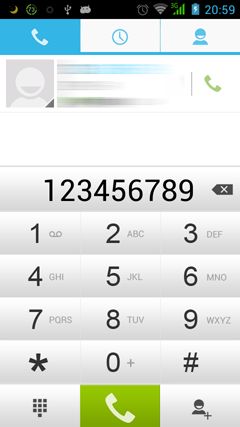Android之拨打接挂电话功能实现
手机是现代人们必不可少的工具之一,而使用得最多的就是拨打电话接听电话,本文通过一个简单的例子实现这个功能。
首先,加入我们的电话处理类
PhoneUtil.java
package com.sl.callphonedemo;
import java.lang.reflect.InvocationTargetException;
import java.lang.reflect.Method;
import android.content.Context;
import android.content.Intent;
import android.media.AudioManager;
import android.net.Uri;
import android.os.Build;
import android.telephony.TelephonyManager;
import android.text.TextUtils;
import android.view.KeyEvent;
public class PhoneUtil
{
public static String TAG = PhoneUtil.class.getSimpleName();
/**
* 挂断电话
* @param context
*/
public static void endCall(Context context) {
try {
Object telephonyObject = getTelephonyObject(context);
if (null != telephonyObject) {
Class telephonyClass = telephonyObject.getClass();
Method endCallMethod = telephonyClass.getMethod("endCall");
endCallMethod.setAccessible(true);
endCallMethod.invoke(telephonyObject);
}
} catch (SecurityException e) {
e.printStackTrace();
} catch (NoSuchMethodException e) {
e.printStackTrace();
} catch (IllegalArgumentException e) {
e.printStackTrace();
} catch (IllegalAccessException e) {
e.printStackTrace();
} catch (InvocationTargetException e) {
e.printStackTrace();
}
}
private static Object getTelephonyObject(Context context) {
Object telephonyObject = null;
try {
// 初始化iTelephony
TelephonyManager telephonyManager = (TelephonyManager) context.getSystemService(Context.TELEPHONY_SERVICE);
// Will be used to invoke hidden methods with reflection
// Get the current object implementing ITelephony interface
Class telManager = telephonyManager.getClass();
Method getITelephony = telManager.getDeclaredMethod("getITelephony");
getITelephony.setAccessible(true);
telephonyObject = getITelephony.invoke(telephonyManager);
} catch (SecurityException e) {
e.printStackTrace();
} catch (NoSuchMethodException e) {
e.printStackTrace();
} catch (IllegalArgumentException e) {
e.printStackTrace();
} catch (IllegalAccessException e) {
e.printStackTrace();
} catch (InvocationTargetException e) {
e.printStackTrace();
}
return telephonyObject;
}
/**
* 通过反射调用的方法,接听电话,该方法只在android 2.3之前的系统上有效。
* @param context
*/
private static void answerRingingCallWithReflect(Context context) {
try {
Object telephonyObject = getTelephonyObject(context);
if (null != telephonyObject) {
Class telephonyClass = telephonyObject.getClass();
Method endCallMethod = telephonyClass.getMethod("answerRingingCall");
endCallMethod.setAccessible(true);
endCallMethod.invoke(telephonyObject);
// ITelephony iTelephony = (ITelephony) telephonyObject;
// iTelephony.answerRingingCall();
}
} catch (SecurityException e) {
e.printStackTrace();
} catch (IllegalArgumentException e) {
e.printStackTrace();
} catch (IllegalAccessException e) {
e.printStackTrace();
} catch (InvocationTargetException e) {
e.printStackTrace();
} catch (NoSuchMethodException e) {
e.printStackTrace();
}
}
/**
* 伪造一个有线耳机插入,并按接听键的广播,让系统开始接听电话。
* @param context
*/
private static void answerRingingCallWithBroadcast(Context context){
AudioManager localAudioManager = (AudioManager) context.getSystemService(Context.AUDIO_SERVICE);
//判断是否插上了耳机
boolean isWiredHeadsetOn = localAudioManager.isWiredHeadsetOn();
if (!isWiredHeadsetOn) {
Intent headsetPluggedIntent = new Intent(Intent.ACTION_HEADSET_PLUG);
headsetPluggedIntent.putExtra("state", 1);
headsetPluggedIntent.putExtra("microphone", 0);
headsetPluggedIntent.putExtra("name", "");
context.sendBroadcast(headsetPluggedIntent);
Intent meidaButtonIntent = new Intent(Intent.ACTION_MEDIA_BUTTON);
KeyEvent keyEvent = new KeyEvent(KeyEvent.ACTION_UP, KeyEvent.KEYCODE_HEADSETHOOK);
meidaButtonIntent.putExtra(Intent.EXTRA_KEY_EVENT,keyEvent);
context.sendOrderedBroadcast(meidaButtonIntent, null);
Intent headsetUnpluggedIntent = new Intent(Intent.ACTION_HEADSET_PLUG);
headsetUnpluggedIntent.putExtra("state", 0);
headsetUnpluggedIntent.putExtra("microphone", 0);
headsetUnpluggedIntent.putExtra("name", "");
context.sendBroadcast(headsetUnpluggedIntent);
} else {
Intent meidaButtonIntent = new Intent(Intent.ACTION_MEDIA_BUTTON);
KeyEvent keyEvent = new KeyEvent(KeyEvent.ACTION_UP, KeyEvent.KEYCODE_HEADSETHOOK);
meidaButtonIntent.putExtra(Intent.EXTRA_KEY_EVENT,keyEvent);
context.sendOrderedBroadcast(meidaButtonIntent, null);
}
}
/**
* 接听电话
* @param context
*/
public static void answerRingingCall(Context context) {
if (Build.VERSION.SDK_INT >= Build.VERSION_CODES.GINGERBREAD) { //2.3或2.3以上系统
answerRingingCallWithBroadcast(context);
} else {
answerRingingCallWithReflect(context);
}
}
/**
* 打电话
* @param context
* @param phoneNumber
*/
public static void callPhone(Context context, String phoneNumber) {
if(!TextUtils.isEmpty(phoneNumber)){
try {
Intent callIntent = new Intent(Intent.ACTION_CALL, Uri.parse("tel:"+ phoneNumber));
context.startActivity(callIntent);
} catch (Exception e) {
e.printStackTrace();
}
}
}
/**
* 拨电话
* @param context
* @param phoneNumber
*/
public static void dialPhone(Context context, String phoneNumber){
if(!TextUtils.isEmpty(phoneNumber)){
try {
Intent callIntent = new Intent(Intent.ACTION_DIAL, Uri.parse("tel:"+ phoneNumber));
context.startActivity(callIntent);
} catch (Exception e) {
e.printStackTrace();
}
}
}
}
然后,在界面上增加四个操作按钮
activity_main.xml
<LinearLayout xmlns:android="http://schemas.android.com/apk/res/android"
xmlns:tools="http://schemas.android.com/tools"
android:layout_width="match_parent"
android:layout_height="match_parent"
android:paddingBottom="@dimen/activity_vertical_margin"
android:paddingLeft="@dimen/activity_horizontal_margin"
android:paddingRight="@dimen/activity_horizontal_margin"
android:paddingTop="@dimen/activity_vertical_margin"
tools:context=".MainActivity"
android:orientation="vertical" >
<TextView
android:layout_width="wrap_content"
android:layout_height="wrap_content"
android:text="@string/hello_world" />
<Button
android:id="@+id/btn1"
android:layout_width="fill_parent"
android:layout_height="wrap_content"
android:text="拨电话"/>
<Button
android:id="@+id/btn2"
android:layout_width="fill_parent"
android:layout_height="wrap_content"
android:text="打电话"/>
<Button
android:id="@+id/btn3"
android:layout_width="fill_parent"
android:layout_height="wrap_content"
android:text="接电话"/>
<Button
android:id="@+id/btn4"
android:layout_width="fill_parent"
android:layout_height="wrap_content"
android:text="挂电话"/>
</LinearLayout>
接着,在主界面程序中实现功能
package com.sl.callphonedemo;
import android.os.Bundle;
import android.app.Activity;
import android.content.Intent;
import android.view.Menu;
import android.view.View;
import android.view.View.OnClickListener;
import android.widget.Button;
public class MainActivity extends Activity
{
Button btn1,btn2,btn3,btn4;
@Override
protected void onCreate(Bundle savedInstanceState)
{
super.onCreate(savedInstanceState);
setContentView(R.layout.activity_main);
btn1 = (Button)findViewById(R.id.btn1);
btn2 = (Button)findViewById(R.id.btn2);
btn3 = (Button)findViewById(R.id.btn3);
btn4 = (Button)findViewById(R.id.btn4);
btn1.setOnClickListener(listener);
btn2.setOnClickListener(listener);
btn3.setOnClickListener(listener);
btn4.setOnClickListener(listener);
}
private OnClickListener listener = new OnClickListener()
{
@Override
public void onClick(View v)
{
Button btn = (Button)v;
Intent intent = new Intent();
switch (btn.getId())
{
case R.id.btn1://拨电话
PhoneUtil.dialPhone(MainActivity.this, "13123456789");
break;
case R.id.btn2://打电话
PhoneUtil.callPhone(MainActivity.this, "13123456789");
break;
case R.id.btn3://接电话
PhoneUtil.answerRingingCall(MainActivity.this);
break;
case R.id.btn4://挂电话
PhoneUtil.endCall(MainActivity.this);
break;
default:
break;
}
}
};
}
当然,不能忘了设置权限
<uses-permission android:name="android.permission.CALL_PHONE"/>
拨电话效果
打电话效果
关于接电话和挂电话,我这里无法演示。以后如果需要可以在程序中调用这个功能。
好了,就到这了,谢谢大家的支持!


